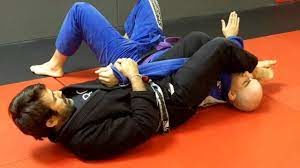Armbars
by: Russ Helm
In this article I will try to offer a means of approaching the arm lock submission. Taking time to intently study a position, or submission, is a fantastic way to improve your jiu jitsu. It applies a focus to your training and will begin to highlight finer details of the position such as connection and weight distribution. These kinds of details are not always apparent when first viewing, or attempting, a position and require time spent and reps repped. As with any endeavor, it is helpful to have a plan of attack. Below are three possible phases for studying the arm lock. Each will include references to specific positions and some general details.
The first phase of this plan involves studying the straight arm lock from the mount and from the back mount. While you will set up the position differently in each, the ending position is the same (i.e. bottom cross-side arm lock). To start with, learn the arm lock versus the two arm push from the mount, and the figure four arm lock from the back mount. When you land in the top arm lock position, pay close attention to details like: toes crossed, heels tucked, knees pinched, elbow at belly button, hands at the wrist, and their thumb in the air. Make sure that you can confidently demonstrate good mechanics and control for both of these techniques.
During this phase you should also learn the Hitchhiker arm lock escape; which is a very basic counter to the bottom cross-side arm lock. Important details for this escape include: hips off the mat, thumb down to the mat on the trapped arm, walk your spine parallel to your partner while keeping your hips up, long step to your knees, and pass the guard. Spend some time working on these positions before you move on.
The second phase of this plan involves studying the straight arm lock from the bottom of the closed guard. There are two primary mechanical approaches to the straight arm lock from guard. The first is a climbing mechanic and is often the first arm lock learned from the closed guard. It involves placing a foot on your opponent’s hip, using that connection to pivot your body, and then climbing into the final arm lock position. The second is a pendulum mechanic, involving swinging the outside leg around and using that momentum to land in the final arm lock position. There are various hand positions for each, however, two common starting positions are as follows: for the climbing variation use a two on one grip on the trapped arm (cross grip behind the elbow, same side grip at the wrist) and for the pendulum arm lock use a cross side grip on top of the inside shoulder while the inside arm scoops inside their leg. Keep in mind these grips are only suggestions. The details of the final position are the same regardless of the setup: pinch your knees, point your toes, cross your toes (not your ankles), two hands on the wrist and hips up to finish. The defense to focus on for this phase is the stacking defense. This will allow you to defend the arm lock when you are inside someone’s guard. Some details for one variation of this defense include: figure four your arms, high knee close to their head, low knee in the back and posted like a kickstand to support their hips, slowly eke the elbow free, free the entire arm, and pass.
During this phase you could also begin to research additional setups for mount and back mount arm locks. For example, exploring choke and arm lock combinations from each position. Lastly, take time to explore alternative escapes to the bottom cross side arm lock like the figure four escape or sitting up into closed guard.
In the final phase of this plan, it’s time to take the reins and follow paths that interest you. You could explore how to hit straight arm locks from other positions such as knee on belly, side mount, or kesa gatame. You could also begin to incorporate variations on the straight arm lock such as the reverse arm lock. The reverse arm lock could be investigated from mount and guard, and can even be combined with straight arm lock attacks. Be sure not to abandon arm lock variations from earlier phases. Although the focus of your study and drilling will be on newer material, you should continue to spend time refining the positions you started with. Some players to watch that have excellent arm lock games include the Camarillo brothers (both Dan and Dave) and Neil Adams (Judo Olympian). Good luck.


